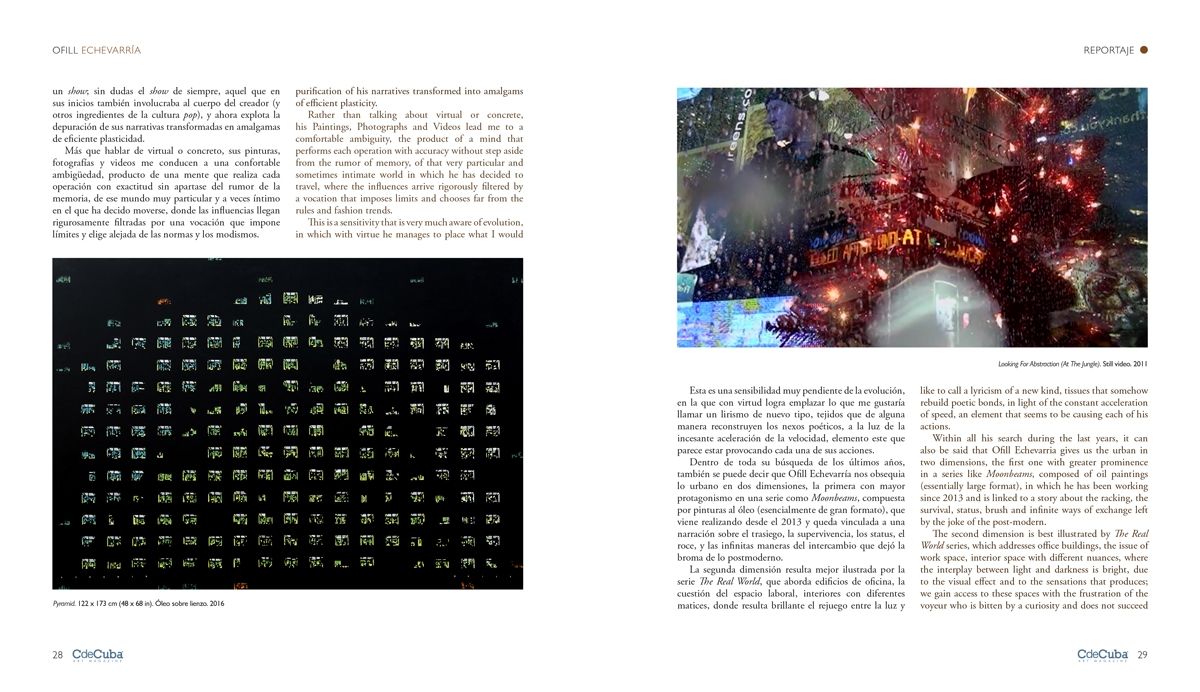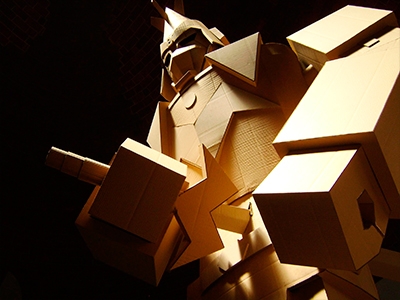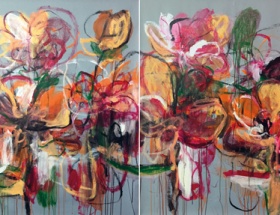[vc_row][vc_column][vc_column_text]
From the Labyrinth to Vertigo
By Ricardo Alberto Perez
The scenario of the city is fermented without limits, within this rhizomatic drama, art is involved, opines, creates metaphors able of representing processes and scenes of that life that we carry altogether.
Thus, poetics appear that contain in themselves the gift of dynamiting and then recover from the image, the remarkable wisdom that is obtained from the created gap. In that trend places itself the work of Ofill Echevarria (Havana, 1972), who brings among its main marks a permeated radical gesture of a history that comes from the second half of the eighties, when as a member of the mythical group Arte Calle, already experienced the issues of the city as an extension of his own body.
From its arrival in Mexico in 1992, until the present that resides in New York, the mutations in Echevarria’s work exhibit a strong coherence, which transforms the spontaneous instinct into a kind of spiritual and formal ascent, like if the creative restlessness prevails over the local signs, and to some extent, ephemeral, to enlist in a transcendence linked to the destiny of things as they are, without having to be constantly tied to ethical or moralistic valuations. That gives this art a particular freshness, a deeply cosmopolitan breath and a rhythm well attached to each of the impulses that are developing in these times.
His work reaches a dynamic in which languages such as Photography, Video, and Painting establish a microcosm capable of solving an admirable number of symbolic operations. The skilled viewer, interested in deepening in its contents will find the magic of a balance that does not deny the intensity, but instead feeds it from a perspective that interprets the form as the point of arrival of a trip through multiple mazes in which in one or another occasion the mentioned vertigo has not been missing, as well as the always catalyst scourge of the dreamlike.
In these pieces an additional mobility is perceived, events that revolve and survive in an organic beauty of distortion. Looking further I have come to feel that the artist thinks that if the eye supports without giving up, or without being eaten by boredom, there is the imagined (or calculated) consumer. The one that moves emotion and idea with the essential coordination so that its boat does not wreck or lags behind the demands of a show; undoubtedly the show of always, the one that in its beginnings also involved the body of the creator (and other ingredients of Pop culture), and now exploit the purification of his narratives transformed into amalgams of efficient plasticity.
Rather than talking about virtual or concrete, his Paintings, Photographs and Videos lead me to a comfortable ambiguity, the product of a mind that performs each operation with accuracy without step aside from the rumor of memory, of that very particular and sometimes intimate world in which he has decided to travel, where the influences arrive rigorously filtered by a vocation that imposes limits and chooses far from the rules and fashion trends.
This is a sensitivity that is very much aware of evolution, in which with virtue he manages to place what I would like to call a lyricism of a new kind, tissues that somehow rebuild poetic bonds, in light of the constant acceleration of speed, an element that seems to be causing each of his actions.
Within all his search during the last years, it can also be said that Ofill Echevarria gives us the urban in two dimensions, the first one with greater prominence in a series like Moonbeams, composed of oil paintings (essentially large format), in which he has been working since 2013 and is linked to a story about the racking, the survival, status, brush and infinite ways of exchange left by the joke of the post-modern.
The second dimension is best illustrated by The Real World series, which addresses office buildings, the issue of work space, interior space with different nuances, where the interplay between light and darkness is bright, due to the visual effect and to the sensations that produces; we gain access to these spaces with the frustration of the voyeur who is bitten by a curiosity and does not succeed in satiate it outrightly.
In short, the most punctual message of this whole trajectory, –in which we must mention a series of videos (Double Body Day, Looking For Abstraction, Modermundo) capable of providing very valuable elements to fully enjoy the rest of its creation– is to learn to contemplate without melodrama the continuous “check!” that development itself poses to identity; although suddenly one of his canvases highlights a Red Bag that tells us: “this individual exists”.
Artist’s website[/vc_column_text][/vc_column][/vc_row][vc_row][vc_column][vc_column_text]
[/vc_column_text][/vc_column][/vc_row]





